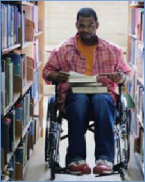< Previous | Contents | Next >
Mobility Disabilities

Many types of orthopedic or neuromuscular disabilities can impact mobility. These disabilities include but are not limited to amputation, paralysis, cerebral palsy, stroke, multiple sclerosis, muscular dystrophy, arthritis, and spinal cord injury. Mobility disabilities range from lower body disabilities, which may require use of canes, walkers, or wheelchairs, to upper body disabilities, which may include limited or no use of the upper extremities and hands. Mobility disabilities can be permanent or temporary. (DO-IT 2004)
Functional Limitations
It is impossible to generalize about the functional abilities of students with mobility disabilities. Mobility disabilities may impact students’ strength, speed, endurance, coordination, manual dexterity, range of motion, and control of limbs, in various ways and to varying degrees. Students may experience difficulties that include but are not limited to:
Chronic fatigue or pain
Difficulty maintaining stamina
Difficulty walking, standing, lifting, or sitting for a long time
Lateness to class or attendance
Problems with physical access to, and movement in, classrooms and labs
Difficulty manipulating objects, such as pages, pens, computers, and lab equipment.
Accommodations
Accommodation needs of students with mobility disabilities vary greatly by individual and academic activity. Examples of accommodations for students with mobility disabilities include:
Accessible locations for classrooms, labs, and field trips
Wide aisles and uncluttered work areas
Adjustable-height and tilt tables
Easily reachable equipment
Note-takers, scribes, and lab assistants
Assistance with group activities
Extended time on exams and or alternative testing arrangements
Assistive technology
Course materials available in electronic format
Teaching Strategies
Be prepared to listen, and involve the student in finding a solution to his challenges in the course
Understand that occasional lateness or absence may be unavoidable
Plan appropriate seating to integrate students into the class; avoid relegating them to a doorway, a side aisle, or the back of the room
Plan ahead for off-campus assignments and fieldwork as these may pose problems of access for the student
Know the college’s emergency evacuation plan, and assure that it is manageable for your students with mobility disabilities
Our Sources and Additional Resources:
DO-IT Home: The Faculty Room (University of Washington):
http://www.washington.edu/doit/Faculty/
DO-IT Home: Mobility Impairments (University of Washington):
http://www.washington.edu/doit/Stem/mobility.html
Fast Facts for Faculty: Teaching Students with Medical/Mobility Disabilities (Ohio State University Partnership Grant):
http://ada.osu.edu/resources/fastfacts/Medical_Mobility_Disabilitie s.htm
< Previous | Contents | Next >

